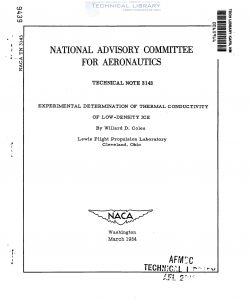naca-tn-3143
- Version
- 150 Downloads
- 529.88 KB File Size
- 1 File Count
- January 23, 2017 Create Date
- January 23, 2017 Last Updated
National Advisory Committee for Aeronautics, Technical Notes - Experimental Determination of Thermal Conductivity of Low Density Ice

The thermal conductivity of low-density ice has been computed from
data obtained in an experimental investigation of the heat transfer and
mass transfer by'sublimation for an iced surface on a flat plate in a
high-velocity tangential air stream.
The results are compared with data from several sources on the
thermal conductivity of packed snow and solid glaze ice. The results
show good agreement with the equations for the thermal conductivity of
packed snow as a function of snow density. The agreement of the curves
for packed snow near the solid ice regime with the values of thermal
conductivity of ice indicates that the curves are applicable over the
entire ice-density range.
Removal of ice formations which secrete on aircraft surfaces from
the impingement and freezing of cloud droplets has been the subject of
a considerable amount of research in recent years. The accumulation of
ice on aircraft surfaces occurs over a range of air temperatures from
52° F to as low as —40° F (ref. 1). The ice formations may be nearly
clear glaze ice with little porosity, such as those formed at air tem-
peratures near the freezing point, or they may'be of the very porous
type characterized by frost or ice formed at low temperatures. Some
factors which affect the nature of the ice formations are the speed of
the aircraft and the cloud droplet size and droplet size distribution.
Very few data are available on the physical properties of ice formations
having a density other than that of clear, solid ice. Since much of the
de-icing of aircraft is currently accomplished by the application of
heat to the surface to be de-iced, knowledge of the thermal conductivity
of ice is of importance in determining the heat lost through the ice.
A similar prdblem is encountered in the determination of heat-transfer
rates for frosted refrigeration equipment surfaces. A study of the mass
transfer by sublimation and the heat transfer for an iced surface in a
high-velocity air stream (ref. 2) required the determination of ice den-
sity, ice surface temperature, and rate of heat flow through the ice.
| File | Action |
|---|---|
| naca-tn-3143 Experimental Determination of Thermal Conductivity of Low Density Ice.pdf | Download |

Comment On This Post